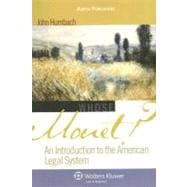
Note: Supplemental materials are not guaranteed with Rental or Used book purchases.
Purchase Benefits
What is included with this book?
| Introduction | p. 1 |
| The Lawyer's Task: Facts and Law | p. 9 |
| The Facts | p. 10 |
| Facts of DeWeerth v. Baldinger as Summarized by the Trial Court | p. 17 |
| The Law | p. 21 |
| Deciding Whether to Sue | p. 27 |
| Deciding Where to Sue: The Court System | p. 31 |
| Federal Court System | p. 33 |
| A Note on "Civil" and "Criminal" Cases | p. 37 |
| District Courts | p. 39 |
| United States Courts of Appeals | p. 42 |
| Supreme Court of the United States | p. 44 |
| Other Federal Courts | p. 45 |
| State Court Systems | p. 45 |
| Trial Courts | p. 47 |
| State Courts of Appeals | p. 48 |
| State Supreme Courts | p. 49 |
| Other State Courts | p. 50 |
| The Best Court for Mrs. DeWeerth? | p. 51 |
| Commencing a Civil Action | p. 55 |
| The Complaint | p. 63 |
| The Content of Pleadings | p. 65 |
| The Complaint's Legal Sufficiency-A Motion to Dismiss | p. 67 |
| Decision on Motion to Dismiss | p. 74 |
| DeWeerth v. Baldinger I | p. 74 |
| A Note on "Briefing" Cases | p. 79 |
| The Common Law | p. 83 |
| The Emergence of American Common Law | p. 90 |
| Kerwhacker v. Cleveland, Columbus & Cincinnati RR | p. 96 |
| The Fluidity of the Common Law | p. 98 |
| The Stability of the Common Law-Stare Decisis | p. 105 |
| Hart v. Massanari | p. 116 |
| The Answer | p. 121 |
| "Discovery" | p. 125 |
| A Motion for Summary Judgment | p. 131 |
| O'Keeffe v. Snyder | p. 134 |
| DeWeerth v. Baldinger II | p. 144 |
| Statutory Law and Administrative Regulations | p. 153 |
| What Statutes Are Supposed to Do | p. 155 |
| How Statutes Get Enacted | p. 159 |
| Administrative Regulations | p. 161 |
| Interpreting Statutes | p. 164 |
| Interpreting the Statute in DeWeerth | p. 168 |
| The Trial | p. 171 |
| Selecting the Jury (Voir Dire) | p. 174 |
| Opening Statements | p. 176 |
| Presenting the Testimony and Other Evidence | p. 177 |
| Motions for Judgment as a Matter of Law or Judgment of Acquittal | p. 180 |
| Closing Arguments | p. 181 |
| Charge to the Jury | p. 182 |
| The Judgment (and a Motion for a "Judgment N.O.V.") | p. 185 |
| The Appeal | p. 189 |
| DeWeerth v. Baldinger III | p. 193 |
| The Aftermath | p. 207 |
| Solomon R. Guggenheim Foundation v. Lubell | p. 208 |
| DeWeerth v. Baldinger IV | p. 212 |
| DeWeerth v. Baldinger V | p. 214 |
| Postscript | p. 219 |
| Extracts from Testimony of Gerda Dorothea DeWeerth | p. 223 |
| Table of Contents provided by Ingram. All Rights Reserved. |
The New copy of this book will include any supplemental materials advertised. Please check the title of the book to determine if it should include any access cards, study guides, lab manuals, CDs, etc.
The Used, Rental and eBook copies of this book are not guaranteed to include any supplemental materials. Typically, only the book itself is included. This is true even if the title states it includes any access cards, study guides, lab manuals, CDs, etc.